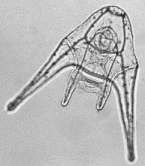- Observe cell division
- Observe swimming blastula (possibly see hatching)
- Observe swimming gastrula embryos
- Observe swimming pluteus larvae
Timing
- This lab is ideally done in an extended lab period of several hours, but it can be done with an initial 45-50 minute period the first day.
- Subsequent days: Day 2 = 30 minutes, Days 3,4,5 = 15 minutes plus analysis time.
Background
This is how our own lives began. The early events in sea urchins are very similar to that in humans and other animals. In fact, except for timing, the stages from fertilization to gastrulation are almost identical. Since sea urchins have external development, it is very easy to observe. Development to the larval stage occurs in a few days.
Sea urchin development was one of the first to be observed in detail. Nearly a hundred years ago, Jacque Loeb studied sea urchins at Hopkins Marine Station. His papers made quite a "splash" in the popular press of the time when he showed it was possible, though a process called parthenogenic activation, to activate egg development without a sperm from the male!
There are many similarities in human and sea urchin development, especially in early developmental stages. One of the differences in early development is how the divisions occur.

Sea urchin on the left and mammal on the right. For a review of mitosis see the animation Mitosis.
Materials
- Urchin Kit
- Microscopes
Procedure
Spawn sea urchins [see Gametes lab]. Fertilize with a minimum amount of sperm [see Fertilization and Sperm Dilution labs]. Keep dilute cultures of embryos, at less than 1% concentration, in sea water no more than 1 cm deep or in slowly stirring cultures.
Timing:
This is different for each species and is HIGHLY temperature dependent (at warmer temperatures under a microscope, division is faster). examples:
|
species |
nuclei fuse and center | centro-some streak | metaphase | 1st division | 2 nd division | blastula | gastrula | pluteus |
| pictus 18C | 20' | 50' | 80' | 90' | 2.5 hrs | 24 hrs | 2 days | 5 days |
| purp 12C | 30' | 60' | 90' | 120' | 3 hrs | 24 hrs | 2 days | 5 days |
What you usually have to do is set cultures up at different times, including the day before. See Gametes for suggestions on how to store gametes for long periods of time.

This lesson is often done when mitosis and meiosis are discussed. Comparing the steps leading up to first division in sea urchins and onion root tip can help students see the differences between plant and animal cell division.
See animations of early development in the sea urchin:

Normal Early Blastula

Pluteus at 5 days
Students should keep careful records of when each of the recognizable development steps occurs. Detailed drawings are very helpful. If you are lucky enough to have two species or two different temperature environments, students can compare stages and rates of development.
Did the embryos make it to the pluteus stage? If not, what limited their development? (temperature, oxygen supply, sperm and egg concentrations, etc. see Experiments lab).
Compare the rates of survival at each of the stages. What percentage of the fertilized eggs survived at each stage?
The lab is very different from the open ocean. What could be done to better approximate "normal" conditions?
Implications
The process of development is very complex with lots of possibilities for things to go wrong. What would happen if:
- the sperm could not get into the egg?
- the male and female pronuclei did not fuse?
- DNA synthesis did not occur?
- the centrosome did not align the chromosomes properly at metaphase?
- the actual division was not competed or happened at the wrong location?
- one cell was removed or damaged at the 2 cell, 4 cell, 8 cell stage?
- at the two cell stage the two cells were separated and allowed to develop on their own? at the 4 cell stage?
- hatching did not occur?
- gastrulation went out instead of in?
- skeleton failed to form in the pluteus?
Further questions for thought:
- Why do cells with multiple chromosomes need the complex steps of mitosis to divide in comparison to the steps of binary fission in bacteria?
- What are the adaptive advantages of external fertilization? What are the adaptive advantages of internal fertilization?
- What are the adaptive advantages of external development? What are the adaptive advantages of internal development?
Evaluation
- Active participation. This is a group assignment. Make sure everyone is allowed to and does participate.
- Lab reports - layout, tables, drawings, etc.
- Answers to Interpretation and Implication questions.
